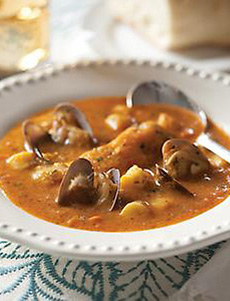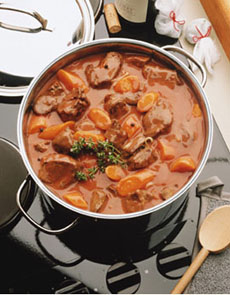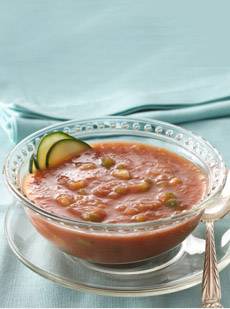
 Bouillabaisse with a roux thickener. Photo courtesy CBCrabcakes.com Bouillabaisse with a roux thickener. Photo courtesy CBCrabcakes.com
|
JOHNNY GNALL is a chef and freelance writer based in San Francisco.
|
|
February 2012 |
 |
Sauce, Stew & Soup Thickeners
Page 2: Ragu & Bread
This is Page 2 of three-page article on soup thickeners. Click on the black links below to visit other pages.
Ragu
A ragu is a type of slow-simmered gravy or sauce, typically used in a stew rather than a soup or sauce. The process is a bit looser and less technical than the roux and slurry on the previous page, but that’s Italian cooking for you.
If you grew up Italian or visited friends of Italian descent, you probably saw a pot simmering on the stove for at least eight hours every Sunday. The pot contained what many Italians refer to as “gravy,” which can be anything from a hearty tomato sauce to a rich meat ragu or sugo (the Italian word for sauce). The process is not exclusively Italian, but our association with it is.
With a ragu, time is your thickener. You can start a sauce like this before breakfast, and the longer you wait to serve dinner, the more delicious it will be.
- Sear & Sweat. A good start to such a sauce would be some diced pancetta, minced carrots, celery, onions and garlic. Sear the pancetta, deglaze the pan and sweat the vegetables for a while.
- Simmer. Then add some stock or water, tomatoes, bring to a simmer and leave it. After several hours, everything in the pot begins to break down and add body to the sauce.
A sauce like this is not going to have the same consistency and texture in its body as one with a more methodic thickening will. But you’d be surprised how rich and creamy a ragu can get.
|
|

Beef stew, thickened with a ragu, sim-
mering on the stove. Photo courtesy
Dakota Beef. |
Moreover, the ingredients that break down to thicken are foods that impart their own tastes and flavors: carrots and onions give sweetness, tomatoes provide acidity, etc.
- Add Meat Gelatin. You can also get thickness in this method by cooking with gelatinous meats, like oxtail. Even a few hearty bones in your pot will do the trick. The gelatin they release into your dish over time will add tons of flavor as well as impart texture and thickness.
- Stir. Just don’t forget to check and stir every once. You’re going to get concentration of flavor and texture from the evaporation of whatever liquid you’re using, so don’t be afraid to add more liquid throughout the cooking process if you want to let things cook for longer.
Bread
Bread is one of the ingredients that thickens a traditional Spanish gazpacho, and the whole process couldn’t be easier. All you need to do is tear the white out of a loaf of bread, put the pieces into a blender with some tomatoes and other vegetables, and puree it all down to soup. Naturally, seasoning and spices are required, but the process is essentially that simple.
As the soup sits overnight, the bread breaks down even further so that by morning, it has a wonderful chowder consistency. Most people would not realize there is bread in the soup.
You can apply this same method to any sauce or soup.
- Purée. Try puréeing chicken broth with bread for a heartier, thicker base.
- It’s not going to work with every single soup (think complementary ingredients), but it’s worth experimenting with and may yield you a fresh take on an old favorite soup recipe.
- In a pinch, use bread to thicken a sauce.
|
|

Gazpacho, traditionally thickened with bread. Photo courtesy Muir Glen. |
Continue To Page 3: Soup Thickener Types Including Rice
Go To The Article Index Above

|




 Bouillabaisse with a roux thickener. Photo courtesy CBCrabcakes.com
Bouillabaisse with a roux thickener. Photo courtesy CBCrabcakes.com
